The spring rush in the landscape industry can put everyone in a plant-buying frenzy. Warmer weather, sunny days and spring blooms conjure dreams of a newly planted yard, which may lead to hastily purchasing plants. It’s a common mistake to be overtaken by all of the boisterous plants ready for purchase at the nursery and to buy plants with superficially good looks or, worse, just because they have rock-bottom prices, without giving them a good inspection.
Learn to check a plant’s health at the nursery to ensure you are making a wise purchase, because a plant that’s robust from the start is more likely to thrive in your landscape.
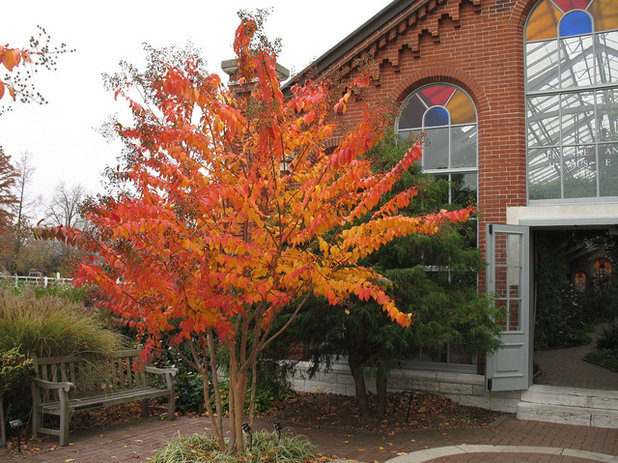
Missouri Botanical Garden
Let’s start with a glossary to help you understand different plant types and the terminology you will encounter in the nursery.
1. Tree Types- Conifers are plants with needles that produce cones and are often wind-pollinated, such as firs (Abies spp.), pines (Pinus spp.) and hemlocks (Tsuga spp.); see how to find the right conifer for your landscape
- Broad-leaved plants have leaves instead of needles and typically produce flowers that are pollinated by insects or birds.
- Deciduous plants lose their leaves or needles in winter; for example, bald cypress (Taxodium distichum) is a deciduous conifer.
- Evergreen plants have leaves or needles year-round; for example, southern magnolia (Magnolia grandiflora) is a broad-leaved evergreen tree.
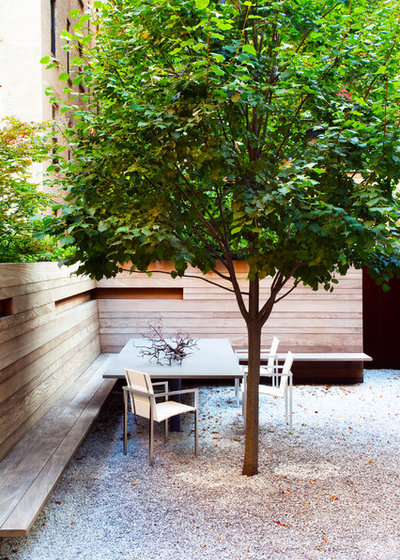
Billinkoff Architecture PLLC
2. Tree Sizes and Availability
Size. The size of plants is defined by either caliper, height or container size.
- Caliper: Typically, shade trees and trees with a single exposed trunk are offered by caliper size, expressed in trunk diameter; for example, a 3-inch caliper for a littleleaf linden (Tilia cordata).
- Height: Height is used for multistemmed trees, multistemmed shrubs and evergreen conifers with branches that begin at the base of the trunk.
- Container size: Container size is based on soil volume. For trees and woody shrubs, container sizes range from 1 gallon to 100 gallons. Large container-grown trees and shrubs are more common in warm climates, because they can be grown from year to year aboveground without suffering frost damage. In cold climates, large trees and shrubs are more often grown in the field, where they can better withstand freezing temperatures.
Availability. The available sizes are related to the form of the tree, which is helpful to know if you are browsing a nursery catalog before visiting, because the catalog will tell you the tree forms that are available and what sizes are available for each species. For example, southern magnolia can be available in a specific height if you want a multistem tree or one that has branches all the way to the ground, but the same species also can be available as a caliper size if you want a tree with the lower branches removed and an exposed single trunk.
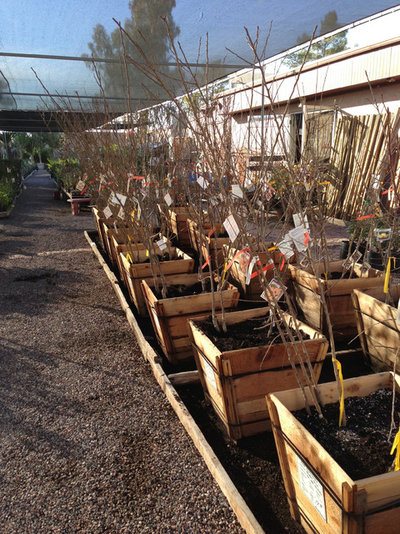
Noelle Johnson Landscape Consulting
3. How Trees Are Packaged
Bare-root. Bare-root plants, like the ones shown here, are surrounded by a protective covering, such as a plastic sleeve or burlap fabric, and the roots are not mingled with soil. The soil in the containers shown here is just there to hold the plants — the roots are not physically growing into the soil.
Bare-root plants most often appear in early spring at the nursery and are great for tree and shrub saplings and plants that you want to purchase in a very small size. Bare-root plants are also very economical if you want to plant many trees or shrubs.
A limited number of species are available as bare-root plants and are available mostly in smaller caliper sizes. Species with long tap roots, for example, are more likely to be found as bare-root and in smaller caliper sizes, because they are easier to transplant than container-grown plants. Large bare-root transplants require professional assistance from a landscape contractor who knows how to work with bare-root plants.
Learn more about bare-root plants
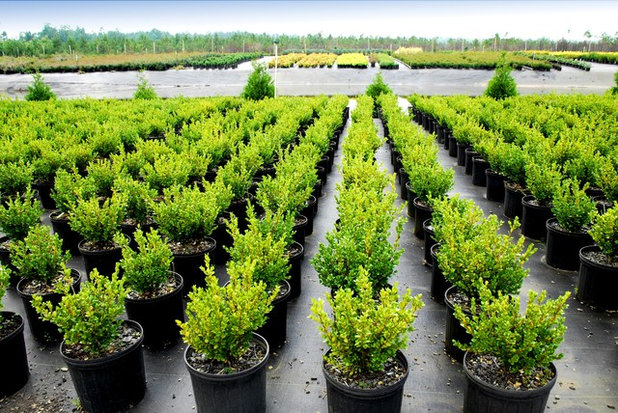
Falon Land Studio LLC
Container-grown. Plants grown in containers have lived their lives growing in a plastic pot. They are started from seed in a tray and then transplanted into larger containers as they grow. Container-grown plants are the most readily available in a retail nursery, because they are easily transported between grower and nursery.
Container-grown plants can present a problem when the root system is root-bound, also called pot-bound, as identified by large roots that circle around the base of the plant. Some amount of minor root circling is completely normal in containers. However, if a tree or woody shrub has its largest roots growing around in circles within the pot, it’s a sign that the tree or shrub has a diminished root structure, and you should not purchase it as a home gardener. Advanced gardeners can purchase these plants if they intend to root-prune them, but for most people it’s easiest to stay clear of root-bound plants — especially trees — because the poor root structure will only cause problems later on.
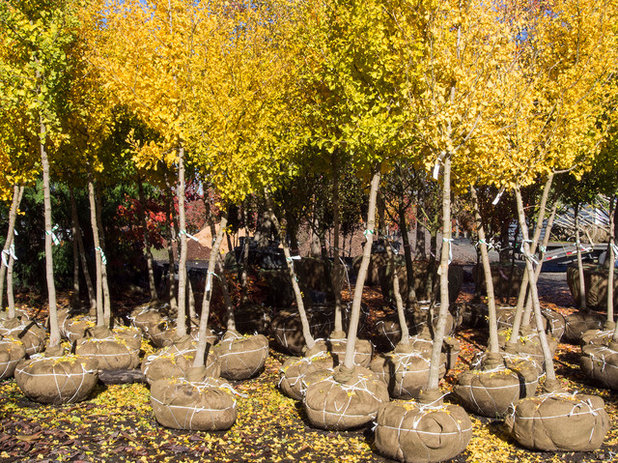 Balled-and-burlapped.
Balled-and-burlapped. When a tree or large shrub is dug up from the field it was grown in, and the majority of the root ball is contained in a wrapped burlap ball and secured with twine or a wire basket, it’s called a balled-and-burlapped (or B&B) plant. Buying a B&B plant is a great way to get a robust field-grown plant that’s ready to be transplanted into your yard. Many species are available in B&B form throughout the frost-free growing season.
Photo by Dana via flickr
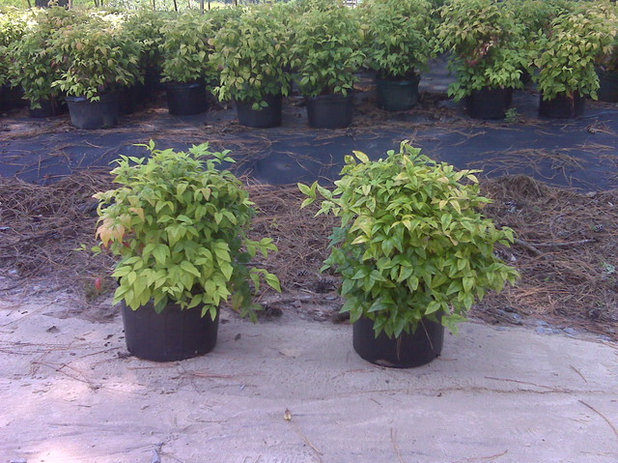
Falon Land Studio LLC
4. What to Look for in a TreeOnce you’re at the nursery, pull your favorite trees out from their group and study their form and growth. Use this checklist to determine if the plant is a good one to buy:
- Strong form: Also called structure or growth habit, the form of a plant should be strong and full. This means there should be no uneven gaps in the canopy or asymmetrical habit. Trees that are single-stem should have one main trunk, or leader. Multistemmed shrubs and trees should be full, with no crossing branches.
- Healthy vegetation: The leaves should be free of major damage from insects and wind, and they should have a uniform color and shape that’s consistent with the species’.
- No bad bugs or fungus present: Stay clear of any plant with questionable bugs, mildew, fungus or discoloration, as it could be a diseased or harshly malnourished plant. Ladybugs, lacewings and some caterpillars, however, can benefit the plant and will happily hitch a ride home to your garden.
Photo by JoCoPlants via flickr
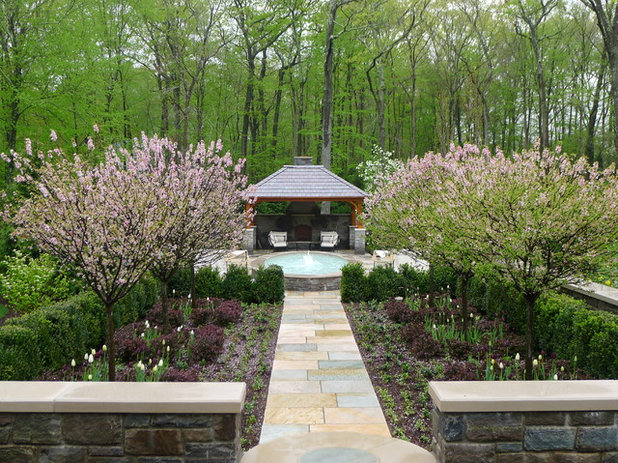
Elise Landscapes & Nursery, LLC
Look for uniformity. Uniform growth is very important when buying multiple plants of the same species that will be grouped together. When planting an allée or a grid of trees, for example, the design’s success hinges on the trees’ uniform growth and planting, as seen here in an allée of cherry trees (
Prunus sp.).
The same is true when you purchase several shrubs of the same species for a hedge or privacy screen. You will want to select a group of plants with similar stature, growth and overall structure to create a uniform screen.
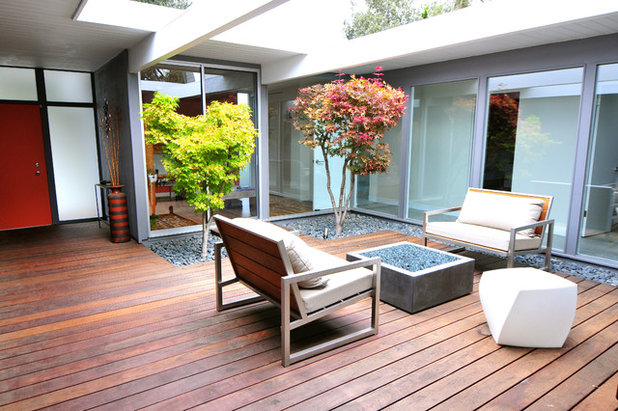
Urbanism Designs
Look for special forms. If you are looking for one specimen tree with a sculptural form, then it’s perfectly OK to choose one that’s different from the crowd. For example, you might want one twisted Japanese maple (
Acer palmatum) or a palm tree with a curving trunk as a focal point in the landscape.
Shown here are two Japanese maple cultivars. Notice how the trees have distinct forms — single-stem versus multistemmed — and color — chartreuse versus orange-red.
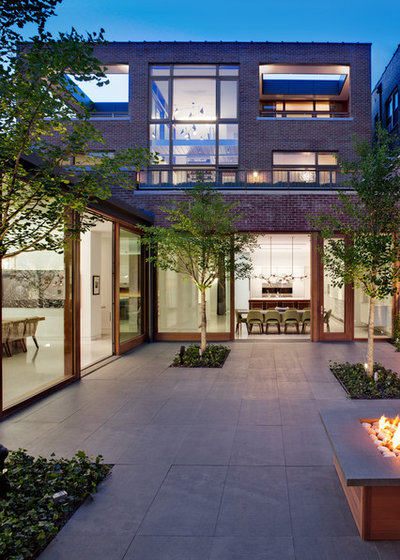
Vinci | Hamp Architects
5. Factors That Influence Price
Young versus mature plants. Generally speaking, small container-grown plants and bare-root plants cost less than larger plants. If you want mature plantings at installation, you should spring for the larger and more expensive size. If you are on a tight budget and don’t mind waiting while your plants grow into maturity, you can buy a smaller size. Younger trees typically experience less transplant shock when you plant them and can be installed by a homeowner if done correctly. Mature trees can be transplanted into your yard, but they require more careful attention to make sure they transplant well, and the help of a professional. The bottom line is that you are purchasing plants at a particular stage of growth, and you will pay more for a plant that the nursery has been growing for a longer period of time.
Species and stock. Plant prices vary widely by species. Even when comparing shade trees of similar caliper sizes, trees that are special cultivars or very slow-growing will be far more expensive than trees that are easy and to grow and that grow quickly. This is based on how nurseries are run as businesses. It’s a greater investment for the nursery to devote time, water, nutrients and labor to produce a slow-growing tree or a tree that is difficult to grow or propagate. The downside to this is that the weedy, fast-growing and potentially invasive plants can be the cheapest ones at the nursery.
Price is also influenced by production timing and availability of stock. Currently, the demand for native plants has increased beyond the nursery industry’s ability to catch up, which means that sometimes natives are difficult to find or more expensive than nonnatives. Stock can change dramatically throughout the year, with spring being the time when retail nurseries are most full of plants.





